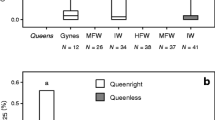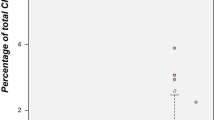Abstract
Queens of many social insect species are known to maintain reproductive monopoly by pheromonal signalling of fecundity. Queens of the primitively eusocial wasp Ropalidia marginata appear to do so using secretions from their Dufour’s glands, whose hydrocarbon composition is correlated with fertility. Solitary nest foundresses of R. marginata are without nestmates; hence expressing a queen signal can be redundant, since there is no one to receive the signal. But if queen pheromone is an honest signal inextricably linked with fertility, it should correlate with fertility and be expressed irrespective of the presence or absence of receivers of the signal, by virtue of being a byproduct of the state of fertility. Hence we compared the Dufour’s gland hydrocarbons and ovaries of solitary foundresses with queens and workers of post-emergence nests. Our results suggest that queen pheromone composition in R. marginata is a byproduct of fertility and hence can honestly signal fertility. This provides important new evidence for the honest signalling hypothesis.


Similar content being viewed by others
References
Bhadra A., Iyer P.L., Sumana A., Deshpande S.A., Ghosh S. and Gadagkar R. 2007. How do workers of the primitively eusocial wasp Ropalidia marginata detect the presence of their queens? J. Theor. Biol. 246: 574-582
Bhadra A., Mitra A., Deshpande S.A., Chandrasekhar K., Naik D.G., Hefetz A. and Gadagkar R. 2010. Regulation of reproduction in the primitively eusocial wasp Ropalidia marginata: on the trail of the queen pheromone. J. Chem. Ecol. 36: 424-431
Bonavita-Cougourdan A., Théraulaz G., Bagnères A.G., Roux M., Pratte M., Provost E. and Clément J.L. 1991. Cuticular hydrocarbons, social organization and ovarian development in a polistine wasp: Polistes dominulus Christ. Comp. Biochem. Physiol. 100B: 667-680
D’Ettorre P., Heinze J., Schulz C., Francke W. and Ayasse M. 2004. Does she smell like a queen? Chemoreception of a cuticular hydrocarbon signal in the ant Pachycondyla inversa. J. Exp. Biol. 207: 1085-1091
Dapporto L., Sledge M.F. and Turillazzi S. 2005. Dynamics of cuticular chemical profiles of Polistes dominulus workers in orphaned nests (Hymenoptera, Vespidae). J. Insect Physiol. 51: 969-973
Engels W. and Imperatriz-Fonseca V.L. 1990. Caste development, reproductive strategies, and control of fertility in honey bees and stingless bees. In: Social Insects: an Evolutionary Approach to Castes and Reproduction (Engels W., Ed), Springer-Verlag, Berlin, pp 167-230
Gadagkar R. 2001. The Social Biology of Ropalidia marginata - Toward Understanding the Evolution of Eusociality. Harvard University Press, Cambridge, Massachusetts.
Heinze J. and D’Ettorre P. 2009. Honest and dishonest communication in social Hymenoptera. J. Exp. Biol. 212: 1775-1779
Izzo A., Wells M., Huang Z. and Tibbetts E. 2010. Cuticular hydrocarbons correlate with fertility, not dominance, in a paper wasp, Polistes dominulus. Behav. Ecol. Sociobiol. 64: 857-864
Johnstone R.A. and Grafen A. 1993. Dishonesty and the handicap principle. Anim. Behav. 46: 759-764
Katzav-Gozansky T., Soroker V. and Hefetz A. 2002. Honeybees Dufour’s gland - idiosyncrasy of a new queen signal. Apidologie 33: 525-537
Keller L. and Nonacs P. 1993. The role of queen pheromones in social insects: queen control or queen signal? Anim. Behav. 45: 787-794
Kokko H. 1997. Evolutionary stable strategies of age-dependent sexual advertisement Behav. Ecol. Sociobiol. 41: 99-107
Liebig J., Peeters C., Oldham N.J., Markstädter C. and Hölldobler B. 2000. Are variations in cuticular hydrocarbons of queens and workers a reliable signal of fertility in the ant Harpegnathos saltator? Proc. Natl Acad. Sci. USA 97: 4124-4131
Maynard Smith J. and Harper D.G.C. 1995. Animal signals: models and terminology. J. Theor. Biol. 177: 305-311
Mitra A. and Gadagkar R. 2011. Can Dufour’s gland compounds honestly signal fertility in the primitively eusocial wasp Ropalidia marginata? Naturwissenschaften 98: 157-161
Mitra A., Saha P., Chaoulideer M.E., Bhadra A. and Gadagkar R. 2011. Chemical communication in Ropalidia marginata: Dufour’s gland contains queen signal that is perceived across colonies and does not contain colony signal. J. Insect Physiol. 57: 280-284
Monnin T. 2006. Chemical recognition of reproductive status in social insects. Ann. Zool. Fenn. 43: 515-530
Peeters C., Monnin T. and Malosse C. 1999. Cuticular hydrocarbons correlated with reproductive status in a queenless ant. Proc. R. Soc. Lond. B 266: 1323-1327
Searcy W.A. and Nowicki S. 2005. The Evolution of Animal Communication Reliability and Deception in Signaling Systems. Princeton University Press, Princeton
Sledge M.F., Boscaro F. and Turillazzi S. 2001. Cuticular hydrocarbons and reproductive status in the social wasp Polistes dominulus. Behav. Ecol. Sociobiol. 49: 401-409
Sramkova A., Schulz C., Twele R., Francke W. and Ayasse M. 2008. Ferility signals in the bumblebee Bombus terrestris (Hymenoptera: Apidae). Naturwissenschaften 95: 515-522
van Zweden J.S. 2010. The evolution of honest queen pheromones in insect societies. Comm. Int. Biol. 3: 50-52
Winston M.L. and Slessor K.N. 1992. The essence of royalty: honey bee queen pheromone. Am. Sci. 80: 374-385.
Zahavi A. 1975. Mate selection - a selection for a handicap. J. Theor. Biol. 53: 205-214
Zahavi A. and Zahavi A. 1997. The Handicap Principle: a Missing Piece of Darwin’s Puzzle. Oxford University Press, New York
Acknowledgments
We thank the Department of Science and Technology, the Department of Biotechnology, the Council for Scientific and Industrial Research and the Ministry of Environment and Forests, Government of India for financial assistance. AM carried out chemical analysis, ovarian dissections and statistical analysis. The paper was co-written by AM and RG, and RG supervised the overall work. All experiments reported here comply with the current laws of the country in which they were performed.
Author information
Authors and Affiliations
Corresponding author
Electronic supplementary material
Below is the link to the electronic supplementary material.
Rights and permissions
About this article
Cite this article
Mitra, A., Gadagkar, R. Queen signal should be honest to be involved in maintenance of eusociality: chemical correlates of fertility in Ropalidia marginata . Insect. Soc. 59, 251–255 (2012). https://doi.org/10.1007/s00040-011-0214-6
Received:
Revised:
Accepted:
Published:
Issue Date:
DOI: https://doi.org/10.1007/s00040-011-0214-6




